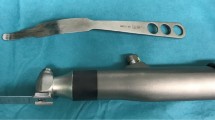Summary.
From 1994 to March 1997, 12 patients with 15 drug-related abscesses of the groin were treated at the Surgical Department of Lübeck Medical University. Besides laboratory, serological and microbiological examinations, the standard diagnostic investigation consisted of sonography or duplex sonography. If indicated, the diagnosis was extended to include, for example, clarification of the retroperitoneum by CT. The most common accompanying disease was deep femoral vein thrombosis. Substitution was planned individually. After surgical débridement and perioperative administration of a beta-lactam-protected acylaminopenicillin, open wound treatment was successfully carried out in 13 cases; secondary closure was performed four times in cases of good compliance. One abscess led to necrotising of the femoral artery; saphenous vein was interposed because of erosion bleeding and formation of aneurysm. In a second case, the bifurcation was reconstructed with saphenous vein after external resection of an infected false aneurysm and early occlusion. Both defects were covered by rotation of sartorius muscle and mesh graft. On the basis of the treatment concept, a rapid and successful intervention was possible; complications such as sepsis, amputation or withdrawal delirium did not occur. Resistance against the antibiotic was not observed. In the case of infected aneurysm, we prefer the autogenous saphenous vein graft followed by rotation of sartorius muscle and mesh graft. Ligation or excision leads to high rates of claudication or amputation; extended reconstructions are threatened by insufficient compliance of the patients; the use of synthetic grafts is endangered by further bacteraemia or infections.
Zusammenfassung.
An der Chirurgischen Universitätsklinik Lübeck wurden von 1994 bis März 1997 12 Drogenabhängige mit 15 Spritzenabscessen der Leisten behandelt. Die Standarddiagnostik bestand neben laborchemischen, serologischen und mikrobiologischen Untersuchungen in der Sonographie bzw. Duplexsonographie. Bei entsprechendem Verdacht wurde die Diagnostik erweitert, z. B. die Abklärung des Retroperitoneum durch CT. Häufigste Begleiterkrankung war die tiefe Beinvenenthrombose. Individuell wurde ein Substitutionsprogramm erstellt. Nach Absceßeröffnung und perioperativer Gabe eines β-Lactamgeschützten Acylaminopenicillins wurde in 13 Fällen erfolgreich die offene Wundbehandlung durchgeführt, bei guter Compliance 4 mal sekundär genäht. Ein Absceß führte zu einer Nekrotisierung der A. femoralis, wegen Arrosionsblutung und Aneurysmabildung wurde die V. saphena interponiert. In einem zweiten Fall wurde nach auswärtiger Aneurysmaresektion und Frühverschluß die Bifurkation mit V. saphena rekonstruiert. Beide Defekte wurden durch Sartorius-Plastik und Meshgraft gedeckt. Aufgrund des Behandlungskonzepts konnte rasch und erfolgreich interveniert werden, Komplikationen wie Sepsis, Amputation oder Entzugsdelir kamen nicht vor. Resistenzen gegen das Antibioticum wurden nicht beobachtet. Beim infizierten Aneurysma bevorzugen wir das Veneninterponat gefolgt von Sartorius-Plastik und Meshgraft. Ligatur oder Excision führen zu hohen Claudicatio- bzw. Amputationsraten, ausgedehntere Rekonstruktionen sind durch die mangelnde Compliance der Patienten bedroht, die Verwendung von Kunststoffen durch rezidivierende Bakteriämien oder erneute Infekte gefährdet.
Similar content being viewed by others
Author information
Authors and Affiliations
Rights and permissions
About this article
Cite this article
Kaiser, M., Kujath, P., Müller, G. et al. Behandlungsstrategie inguinaler Spritzenabscesse und ihrer Komplikationen. Chirurg 68, 1029–1034 (1997). https://doi.org/10.1007/s001040050316
Published:
Issue Date:
DOI: https://doi.org/10.1007/s001040050316




